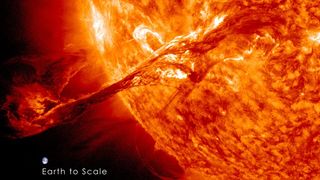Astronomy
Explore Astronomy
Latest about Astronomy

Powerful solar eruption temporarily rips 'tail' off Earth's magnetosphere
By Nathaniel Scharping, Eos.org published
A massive disturbance in the solar wind caused Earth’s magnetosphere to fly without its usual tail.

We finally know where the moon's atmosphere comes from
By Robert Lea published
"We give a definitive answer that meteorite impact vaporization is the dominant process that creates the lunar atmosphere."

Space photo of the week: A cosmic butterfly emerges from a star's slow death
By Jamie Carter published
A Hawaii telescope just captured a sun-like star's glowing gas layers as it expands. The resulting butterfly-shaped nebula is a sight to behold.

The building blocks of life can form rapidly around young stars
By Robert Lea published
New research could solve the mystery of how the complex building blocks of life first formed.

Group of ancient stars spotted near the sun could rewrite the Milky Way's history
By Patrick Pester published
Researchers using the Gaia space telescope studied some ancient stars near the sun, revealing that our corner of the Milky Way may be billions of years older than once thought.

These 17th-century drawings of the sun by Kepler add fire to solar cycle mystery
By Elizabeth Howell published
Kepler's sun drawings are the oldest sunspot records with known dates.

Auroras expected tonight and through the weekend as US braces from 'cannibal' solar eruption
By Brandon Specktor last updated
A chain of solar outbursts, including a "cannibal" coronal mass ejection that slammed Earth on Tuesday, will bring lovely auroras to parts of the northern US and most of Canada this weekend. Here's where to look.

James Webb telescope confirms the earliest galaxy in the universe is bursting with way more stars than we thought possible
By Ben Turner published
The light from the most distant galaxy in the known universe suggests that there's something off about our current cosmological models, a new James Webb Space Telescope study finds. The explanations remain elusive.

Once-in-a-lifetime nova explosion from T Coronae Borealis will create a 'new star' in the sky
By Ben Turner published
The T Coronae Borealis nova will soon burst into life above our heads for the first time in 78 years.

A moon of Uranus could have a hidden ocean, James Webb Space Telescope finds
By Robert Lea published
Astronomers using the James Webb Space Telescope have found that Ariel, a moon of Uranus, has some of the most carbon dioxide-rich deposits in the solar system, hinting at a buried water ocean.
Sign up for the Live Science daily newsletter now
Get the world’s most fascinating discoveries delivered straight to your inbox.
